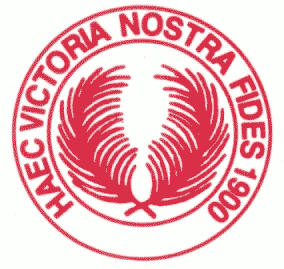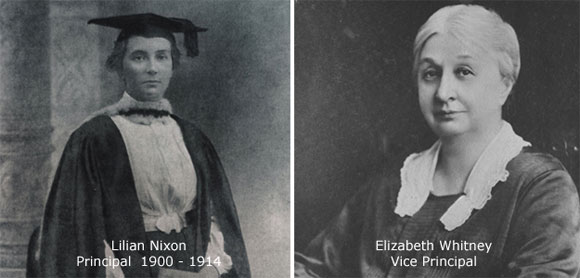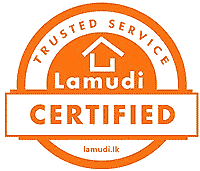CMS Ladies' College, Kollupitiya (Colombo-3)
 CMS Ladies' College crest |
|
|
|
|
|
|
CMS Ladies' College
Sir Ernest de Silva Mawatha, Kollupitiya
Established in 1900
Ladies’ College is a private day and boarding school for girls in Colombo, Sri Lanka. Founded in 1900, Ladies’ College has been in the forefront of private girls’ education in the country for over a century and has a reputation for holistic education and academic excellence. A leading girls' school in Colombo, it was started in Union Place by the Christian Missionary Society as CMS Girls' School. It was brought to its present premises in 1919.
Ladies' College 1900-2000
Edited by Ranjini Obeysekera
Ladies' College, Colombo, 2002-2003
This book is not merely a record of a girls' school's century of existence. It is something, rather, that reminds us and every parent with a daughter, that long ago, women of vision who could see what the future would be, began to educate the girl children of this island. Those were times when parents sought after the education of sons.
Girls were not considered as important enough and for centuries, this had been the pattern. Girls were required to be versed in the domestic and home-keeping arts-cooking, sewing, nursing perhaps, even a nunnery for some; and above all, that all-important manner of being a good wife. Education, if imparted, was limited to an ability to read and write, sing, paint and the ability to play a piano or a violin.
The British era in this island saw a change. We have the story of Marie Musaeus Higgins. For example. In 1830, there were 236 missionary schools with a total student intake of 9,274. This is stated in a report on early British educational activities by Ranjit T. Ruberu. Also, the history of Education in Ceylon tells us of Missions in the island engaged in educational work with the avowed aim of propagating Christianity.
There were the Baptist, Wesleyan, American and Church Missions as well as the Catholic Church. The dedicated women and Catholic nuns who came here full of zeal, laid the foundations of a new educational order. All over the island today, this resurgence that began in the nineteenth century has given us that vital feminine structure and this island, above many, can still be proud of the massive way our women have forged ahead in every social sphere.
Female education, female opportunity, female attunement to the country's aspirations - and finally that indelible female stamp on a country's means and ways. The visionary women who came here in the 1800s surely saw what could come to pass. They were the instruments of female empowerment.
Many today may shrug and say: "What is so important about a hundred-year history of a school?" Ah, but they SHOULD see how important it is. If they are proud of their own female family members who have risen to positions of eminence, this book is important.
If they look to the day their own daughters acquit themselves well, if they are conscious of the role women play in the home and at work as wives, mothers and nurturers of families to come, this book is important.
It must be read and, what is more, taken to heart for it contains that fire that can be kindled in the minds of so many girl-children who will learn to be proud of their own schools and know of the springboards to their own dreams of future success and accomplishment.
First target
Ladies' College is one establishment I knew well enough - it being the first target of my own riotous schoolboy forays from nearby Royal College on "big match" days. We, the denizens of Racecourse Avenue and Flower Road, even had our own song:
There are many colleges in which I'd like to be:
Ladies' and Musaeus and Holy Family!
Schoolboy high jinks? Well, call it that... but let's move on. This centennial volume begins with the coming of a 26-year-old Irish woman (surely with smiling eyes) - Lilian Nixon - who founded the CMS Ladies' College in a bungalow in Union Place, Slave Island, in 1900. Lilian was principal for 15 years.

The bungalow was given her by the Church Missionary Society and she began with a student intake of just two!
Lilian came here armed with an Honours degree in Modern Literature from Trinity College, Dublin and with the added qualifications of being a fully-trained teacher, selected by the CMS, England, to found an educational institution for girls in Ceylon. As the record shows, even in England at that time, there were no schools for the education of women.
All that was thought necessary was "a very little reading, less writing, plain work, pudding making and pickling." Girls could excel at making jams and bottling preserves, making the Christmas pudding, become very red-faced over the kitchen stove and were praised if they could "sew a fine seam." Jane Austen's story of the Bennet family, as the editor says, tells of how daughters Lydia and Kitty Bennet were prepared for the marriage market: "There were little or no opportunities for serious intellectual or professional work." Women had no independence either under the British legal system of those times. It was the law that when a woman married, she surrendered her independence to her husband to whom her property and possessions immediately belonged.
Communal property
Coming to the situation in this country, the same pattern prevailed in the maritime areas though slightly modified in the concept of communal property, but yet, as Ranjini Obeysekere records, "the management of the wife's interest was left to the husband, thereby giving her little or no power in the management, sale or disposal of her share of the communal property.
In the central hill country, however, where Sri Lankan traditional laws prevailed, a woman had the right not only to own, manage and dispose of her property, but also gifts given to a woman on marriage by her parents remained her private property and not a dowry given to her husband. The situation was slowly transformed under colonial influence so that by the latter half of the 19th century, middle-class women throughout Sri Lanka began to be influenced by, and soon adopted the values and mores of Victorian England."
This observation is highly relevant to the saga of education for girls and the incredible saga of Ladies' College. The colonial influence that enwraped this country could be seen today as a stumbling block to the educational empowerment of females - which is why education was not even seen as a service to be provided by the State in Ceylon of the early 19th century.
It took the courage and dedication of the missionary churches and the nuns who came in even though many were fired with the zeal for conversion and proselytisation. We see this all over the island and most marked in the Jaffna peninsula as well. Some of the island's largest schools in their embryonic stage, were mission schools - Ladies' College, Girls High School, Wesley College, Bishop's College, Milagiriya, Presbyterian Girl's School, then the Catholic, Baptist, Protestant institutions.
The churches and missionary societies moved in to fill the gaps and the colonial government was happy to go along with and support this procedure. This was how Lilian Nixon and an older colleague Elizabeth Whitley, moved in to establish Ladies' College, funded by the Ceylon Missionary Society.
Lilian Nixon had to attract students. She also taught Latin, Mathematics, French, English and the Scriptures single-handedly in addition to playground drill, needlework and singing. She also locked horns with the CMS who thought her curriculum was too secular and did not place enough emphasis on the missionary aims of the society. This is where the unique difference of Ladies' College immediately began to be felt.
Whereas the CMS saw its schools-funding programme as a means of proselytisation, teachers of the stripe of Lilian Nixon saw something of greater importance their charges had to be EDUCATED - not CONVERTED. Pupil minds had to be brought to flower, not cocooned in a web of religious ethics.
Lilian persevered in her (call it rebel?) brand of education and launched classes for the Cambridge local exams. This fitted well with the desires of parents and soon, more and more students came in. The keywords were academic excellence and a sound-minded education.
These ideals were as a trailblazer, making Ladies' College a true educational institution and a project that ventured into many professional walks of life. Education ruled. Religion was but an appendage to the ways of the school and although there was the overall persistence in the "classroom and chapel" mode, it was the classroom that prevailed, held precedence. As Ranjini Obeysekere says:" Miss Nixon was not only the founder of Ladies' College but she also laid the groundwork for much that has grown and developed over the years and yet, has remained fundamentally unchanged.
Her focus on academic excellence, on the need to aim for the highest degree of intellectual rigour and discipline, has been a guiding principle throughout the school's history. But academic prowess was never seen as an end in itself. Academic excellence and success were but part of one's rounded intellectual growth and were to be used for the good of the wider society. These principles have been amply illustrated by the succession of Ladies' College students who, over the years, have left their mark on the larger society.
One excellent feature of this book is the way a chronological history of the school is made, page after page, in little dockets at the base. It enables the reader to flow through the years and know of the school's enormous contribution to the country. The number of students who have distinguished themselves in all walks of life make heady reading. I couldn't possibly pack this review with so many names, but some "firsts" deserve mention:
* Rachael Christoffelsz - first to be in charge of a maternity hospital, * May Livera - first to get an FRCS degree, * Savitri Ellepola -first woman Vice Chancellor, Colombo University and first to establish the Faculty of Law at the Open University, * Connie Senanayake - first to organize and run homes for the mentally disabled, * Siva Dassanaike - first woman Desamanya. Her brainchild was 'Laksala', * Sirancee Gunawardena - author of "Medieval Palm Leaf Manuscripts of Sri Lanka", * Mukta Wickremesinghe - conceptualized the Bishop Lakshman Wickremesinghe Memorial Centre at Kurunegala, * Sylvia Gunatilaka - pioneer of the teaching of Buddhism and the teaching of Sinhala at Ladies' College, * Avabi Metha - first woman barrister (1933), * Evelyn MacIntyre - first woman to enter the Ceylon Law College, * Gladys Fernando - first woman to be Chairperson of a Corporation, * Nirmala Kadirgamathamby - first woman Commissioner-General of Inland Revenue, * Premila Kannangara Senanayake - first woman international civil servant, * Imogen Kumarasinghe - first woman Director of Census and Statistics, * Yogaranee Nadaraser - first woman Government Analyst, * Pramila Sivaprakasapillai - first woman engineer and * Dhara Wijesinghe - first woman secretary head a Ministry. Marvellous pathfinder
Oh, I have missed many but in apologizing, I excuse myself in saying that this is really not what this review is all about. Rather, this book is a record of scintillating academic performance. Crammed with detail, with dedicatory articles, a fascinating photo-record and listings of accomplishments in the Arts, the book shines like a bright candle in the dimmer parlours of institutions that can only (should only) seek to emulate and follow in the steps of such a marvellous pathfinder.
What needs to be highlighted is the school's multi-ethnic composition. Ladies' College is open to any girl irrespective of ethnic or religious background. In the time of Miss Nixon, Bishop's College was confined to Christian Girls, while Catholic schools and convents had proselytisation as their primary objective. For Ladies' it was a liberal openness, allowing full rein to the talents of diverse cultural and social groups.
What is more, there is no "elitism". Although rising on firm Christian foundations, the school in 1905 counted among its students Sinhalese, Tamils, Malays, Burghers, Telugus, French, British, Russian, Polish, Greek and Italian students - all using English as a common language. I consider this alone a miracle of sorts!
I do not wish to say much more, but for all those who wish to be visited in a quiet hour by shining spirit of true education - as true as it should be - this is a book to read and treasure. Everything that shaped Ladies' College lies before you: The boarding school, "Uplands", in Kandy during World War II - the move to the "Fernery", Flower Road - the growth under a succession of devoted principals and staff - above all the ethnic harmony that has prevailed even in the most tense and troubled times. Let me quote Sirancee Gunawardana:
Tamil students and staff never felt threatened, they never felt distanced. The Tamil stream in school remained involved in all the activities of the school, and after the ethnic crisis in 1983, nobody thought anything of the fact that in the following years the head prefect, Sharmini Mahendran, was a Tamil.
Gather this book to your heart and understand what Ladies' College really is. Now, new expansion is on the cards, but even as big as it must grow, the legend of the school will prevail and be as an educational bell-ringer to the nation. It is in the words of a former principal, Miss Hitchcock, on the student ethos, is the essence of this great school is encapsulated:
To work freely and openly, to discover for themselves the logical answers to experiment, using practical situations derived from their environment, to employ short-cuts instead of tedious memorisation, and to replace the old time-consuming grind with purposeful and meaningful activity..... to develop more skill and eliminate human waste.
- Carl Muller Daily News Friday Oct 15, 2004
For any information or clarification from the school please contact:
Ladies' College
66, Sir Ernest De Silva Mawatha (Flower Road)
Colombo-7, Sri Lanka
Telephone: (+94) 11 2574303
Fax number: (+94) 11 5518243
Email: lcprincipal@sltnet.lk
Courtesy: kermeey.blogspot.com
| 



